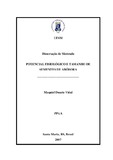| dc.creator | Vidal, Maquiel Duarte | |
| dc.date.accessioned | 2017-05-11 | |
| dc.date.available | 2017-05-11 | |
| dc.date.issued | 2007-02-27 | |
| dc.identifier.citation | VIDAL, Maquiel Duarte. Physiological potential and size of squash seeds. 2007. 59 f. Dissertação (Mestrado em Agronomia) - Universidade Federal de Santa Maria, Santa Maria, 2007. | por |
| dc.identifier.uri | http://repositorio.ufsm.br/handle/1/5176 | |
| dc.description.abstract | The objective of this study was to compare vigor tests in order to evaluate the physiological potential of seed lots, classified according to their size, of four squash species: Menina Brasileira , Caserta , Caravela , and De Tronco . First, the seed lots were submitted to germination tests, as well as to first count, accelerated aging, suboptimal temperature, cold test, evaluation of seedlings under laboratory conditions, emergence at 21 days, emergence
speed index, and hypocotyls length by the emergence. Afterwards, alterations were implemented with respect to the cold test, exposing the seeds to chilling conditions for different periods (three, five, seven, and nine days). The experiments followed a totally randomized design, with four replications. The averages were compared by the Tukey test, at 5% of probability, and the influence of chilling periods by polynomial regression analysis. It was concluded that the squash seed size influences significantly the vigor, and this influence depends on the extent of the differences in terms of size among the classes. From the results, the cold test was found to be the most efficient method to stratify the vigor influence over the different classes of seed size. In addition, as for test conditions, it was concluded that the temperature have to be kept at 10°C, for seven days. What is more, the results indicate that the Pearson s correlation coefficient method was not effective for the purpose of correlating the
behavior of vigor tests under laboratory conditions with the emergence of plants in a greenhouse. | eng |
| dc.description.sponsorship | Coordenação de Aperfeiçoamento de Pessoal de Nível Superior | |
| dc.format | application/pdf | por |
| dc.language | por | por |
| dc.publisher | Universidade Federal de Santa Maria | por |
| dc.rights | Acesso Aberto | por |
| dc.subject | Cucurbita | por |
| dc.subject | Qualidade | por |
| dc.subject | Testes de vigor | por |
| dc.subject | Cucurbita | eng |
| dc.subject | Quality | eng |
| dc.subject | Vigor tests | eng |
| dc.title | Potencial fisiológico e tamanho de sementes de abóbora | por |
| dc.title.alternative | Physiological potential and size of squash seeds | eng |
| dc.type | Dissertação | por |
| dc.description.resumo | O objetivo do trabalho foi comparar testes de vigor para avaliação do potencial fisiológico de lotes de sementes, classificados por tamanho, de quatro variedades de abóbora: Menina Brasileira, Caserta, Caravela e De Tronco. Os lotes de sementes foram submetidos inicialmente aos testes de germinação, primeira contagem, envelhecimento acelerado,
temperatura subótima, teste de frio, avaliação de plântulas em laboratório, emergência aos 21 dias, índice de velocidade de emergência e comprimento do hipocótilo na emergência;
posteriormente foram realizadas modificações no teste de frio, alterando o período de exposição das sementes ao frio (três, cinco, sete e nove dias). Foram conduzidos experimentos
no delineamento inteiramente casualizado, com quatro repetições. As médias foram comparadas pelo teste de Tukey, a 5% e, o efeito dos períodos de frio por análise de regressão
polinomial. Concluiu-se que, há um efeito significativo do tamanho de sementes de abóbora no vigor, dependendo da magnitude das diferenças entre tamanho das classes; o teste de frio foi o mais eficiente para estratificar o efeito do vigor dentro das classes de tamanho de sementes e devem ser mantidas as condições do teste com 10°C de temperatura durante sete dias e, o coeficiente de correlação linear simples (Pearson) não se mostrou eficiente para associar o comportamento dos testes de vigor em laboratório com a emergência de plantas em casa de vegetação. | por |
| dc.contributor.advisor1 | Garcia, Danton Camacho | |
| dc.contributor.advisor1Lattes | http://buscatextual.cnpq.br/buscatextual/visualizacv.do?id=K4702954P8 | por |
| dc.contributor.referee1 | Menezes, Nilson Lemos de | |
| dc.contributor.referee1Lattes | http://lattes.cnpq.br/0551755093817460 | por |
| dc.contributor.referee2 | Lopes, Sidinei José | |
| dc.contributor.referee2Lattes | http://lattes.cnpq.br/7533347017859354 | por |
| dc.contributor.referee3 | Franzin, Simone Medianeira | |
| dc.contributor.referee3Lattes | http://lattes.cnpq.br/9408955824479246 | por |
| dc.creator.Lattes | http://lattes.cnpq.br/8246706207382166 | por |
| dc.publisher.country | BR | por |
| dc.publisher.department | Agronomia | por |
| dc.publisher.initials | UFSM | por |
| dc.publisher.program | Programa de Pós-Graduação em Agronomia | por |
| dc.subject.cnpq | CNPQ::CIENCIAS AGRARIAS::AGRONOMIA | por |


